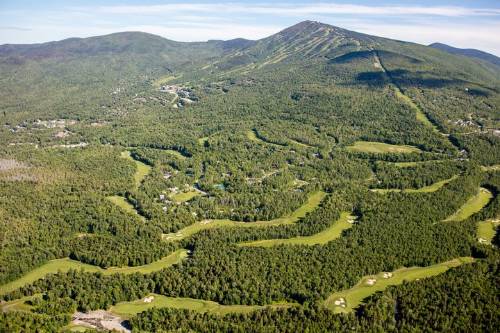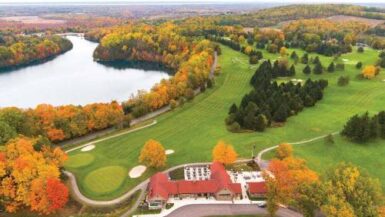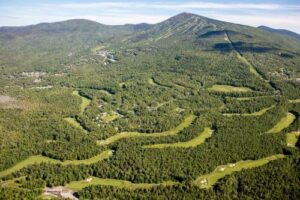
DATELINE: THE WILDERNESS OF WESTERN MAINE – My golf cart is careening around turns, catapulting down tree-lined chutes of concrete, and reeling in the chicanes. First, I’m narrowly missing trees, then I’m splashed in the face by a wall of water, then I’m blinded by flashes and deafened by a sudden cacophony of noise. Grab the “Oh Shit handle” and hang on, because this ride is way wilder than the ski runs.
“Why?” you ask. Thunder and lightning at Sugarloaf Golf Club, that’s why. Zeus is having a conniption up in Olympus, so he’s dealing bolts with both hands like Nolan Ryan fastballs…with me standing in the batter’s box.
So it goes: another trip to Maine, another assignment scuttled by the weather gods.
BOBBY JONES, SKI AREA RESORT CLUBS, AND HOW TO READ A GOLF COURSE
For this story I would play both of golf course architect Bobby Jones’s Maine designs – Sugarloaf and Sunday River – and then interview Bobby and his second in command, Bruce Charlton, (President of RTJ2 Designs), about both courses for an article and radio show. Unfortunately, day turned to night and a washing machine appeared in the sky on the sixth hole of the opening round at Sugarloaf, and everyone skedaddled before the back nine, including me.
A quick primer for all of you new to golf: there are two Bobby Joneses in our sport: Bobby Jones the famous amateur golfer who won the Grand Slam in 1930 and founded Augusta National and the Masters Tournament (not our guy for this story) and Robert Trent Jones, Jr. (“Bobby” to his friends) the famous golf course architect. We’re discussing the latter.
Bobby is second generation international golf design royalty. He is the son of Robert Trent Jones, Sr. (known as “Trent”), a man who designed 400 golf courses, including at least two on every continent on Earth except Antarctica. Bobby has nearly equaled that feat, as has his brother Rees Jones. Additionally, all three have either designed on their own or remodeled multiple major championship venues, particularly the U.S. Open.
Of his 250+ original designs, Bobby has carved out a special niche building courses in the shadow of some of the world’s greatest ski resorts. He’s designed golf courses at five different winter Olympic venues across the globe as well as nearly a dozen great American winter venues, including Crested Butte, Steamboat, and Jackson Hole to name just a few.
“I designed and built both Sunday River and Sugarloaf, and I have fond memories of both of those projects, and made good friends there as well,” Jones recalled. “I built Sugarloaf, which is deep in the wilderness of the Carrabassett Valley, in the early 1980s, and then returned to build Sunday River twenty years later.”
Now that’s critical to note: as fashions, styles, and tastes change over time, so have the science and strategy of golf course design. By studying Sugarloaf, Sunday River, and Bobby’s U.S. Open venue, Chambers Bay, we can not only follow Bobby’s progression as a golf designer, but also the arc of golf design history as well.
HARDER IS NOT BETTER, WIDER IS BETTER
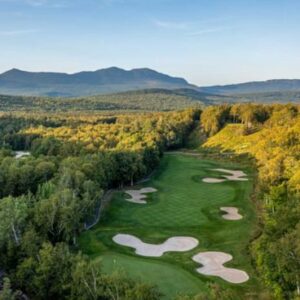
You may not know this, but Neil Armstrong’s first words upon landing the Apollo mission on the moon were not, “One giant leap for mankind,” but instead were “Goddamn that Trent Jones.” (Kidding! Kidding!)
The joke is funny, because it has more than a grain of truth: Bobby’s father Trent was the first “U.S. Open Doctor.” Year in and year out he USGA would bring Trent in before a U.S. Open to tighten fairways in landing areas, (called “wasp-waisting”), and bracket fairways and greens with bunkers; “Penal Architecture” it’s called in the jargon. The classic example is Jones Sr.’s work at Oakland Hills in 1951. Two years earlier, Chicago’s Medinah Country Club gave up record lows in the Open and the USGA and future host clubs were eager to avoid a repeat, so Jones was brought in sharpen host courses’ fangs and claws. Jones’s work was so successful at Oakland Hills, tournament winner Ben Hogan was quoted as saying he was grateful that he “brought this Monster to its knees,” and bestowing that name – “The Monster” upon Oakland Hills South for all eternity.
With Jones’s work immortalized on live television, every course in America followed suit, thinking that by making their golf course as difficult as possible, maybe it too might get on TV, or at least impress locals. Worse still, a generation of architects took up the penal school in both their original designs and – GULP! – hair-brained, half-baked remodels of Golden Age masterpieces. The penal school of architecture remained in vogue from 1941 to around 1995, when we can begin to see the emergence of the Second Golden Age of Golf Course Architecture. This is important for our discussion because a) Sugarloaf was built in the heyday of the penal architecture era, b) Sunday River was not, (therein lies the most critical difference between how the two courses play and appear), and c) Chambers Bay. Bobby’s magnum opus and 2015 U.S. Open design was built after both. And Chambers Bay is clearly the way forward.
SUGARLOAF (THE FRONT NINE ONLY)

Bobby calls Sunday River a mountain golf course, but he instead chooses to refer to Sugarloaf as a wilderness course. I think Sugarloaf is both. Deep in the endless evergreens of the Carrabassett Valley, Sugarloaf feels both miles and years away from civilization and the hustle-bustle of urban life, a perfect vacation getaway. It is the solace from the traffic of the world we all seek.
Opened in 1985, the course is early Bobby, and is reminiscent of some of his father’s tenets. The playing corridors of the golf holes are barely wider than the fairways – in many places, if you miss the fairway, you’re in the woods or creeks that ubiquitously frame both sides and dropping a ball. There are several forced carries either off the tee or into the greens. Add in water hazards, sharp 90-degree dog-legs, wide creeks with rocky beds, cavernous bunkers with myriad noses, and steeply ascending and descending terrain, and a bogey golfer will face a stern test. It’s target golf, and the 90-degree dog-legs – especially on the front-nine par-5s, which are double dog-legs – are the course’s most severe feature. Getting out of position off the tee is punishing for the entire hole because airspace on woodland golf courses is limited.
Next, the bunkers were built during a period when utilizing a large number of hideous, bulbous “noses” was in vogue. Roger Rulewich, who worked closely with Jones for decades, is infamously remembered for saying, “a bunker with four noses is starting to get really interesting.” It was taken to too great an extent at Sugarloaf, where noses sometimes number seven or eight. They not only look unnatural, but they don’t fit well with the gorgeous wilderness surrounds.
The routing of the course follows the Doctrine of Symmetry that all three Joneses frequently employed – two par-5s on each side and two par-3s on each side for a par of 36-36=72. It’s a chore to walk as there are gargantuan distances between greens and the next tee box. At least for the first nine holes you don’t see the ski runs. That’s a disappointment for any course near a ski area and bearing the same name. [Author’s Note: I reserve the right to amend this should the ski runs appear on the back nine.]
That being said, the vertical movement in the land is excellent as there are uneven lies on every hole, and a nice mix of uphill and downhill shots. Some of the greens, such as the third, sixth, and the eighth, have excellent internal contours, though several greens need to be expanded back to the original size of their green pads to recover lost hole locations.
Six is a perfect example, and a hole of which I’m two minds about. A tee shot is played through a chute of trees to the base of a hill, then the approach is completely uphill to a punchbowl green surrounded by trouble. Instead, the bunkers which bracket the green complex should be moved forward and center, making the hole a true replication of the fabled Alps holes designed by architect C.B. Macdonald. The punchbowl green is majestic, as are the views from atop the peak, (at least when not amidst roaring thunderheads). The idea and setting are fantastic, a quick switch of execution would improve the hole even further.
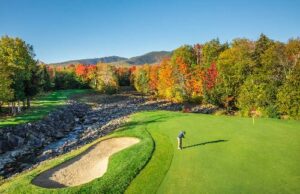
Still, Your Author admits that without playing the “String of Pearls” – what Bobby and the club call the stretch of holes from 10-15 that closely hug the Carrabassett River, any review is incomplete. Admitting that the green settings look gorgeous, nevertheless the question to ask is not how they look but how they play. One thing we know is that there are several forced carries, both off the tee and into the greens, a practice golf designers including Bobby have moved away from in recent decades.
It would be a full 20 years later before Bobby would return to Maine and build Sunday River, and you can clearly see the advancement of more strategic design concepts in is earth. Fairways are wider, greens have more contour, there are more playing angles off the tee, and bunkers have more diverse shapes and dimensions. The golf course is more playable to the average golfer.
““Players love to be able to hit the ball around hazards and not have to hit the ball over hazards all the time. [Moreover, we] reduced the amount of aerial game shots required to score well, thus providing players that have the imagination and the skills to use the ground game an advantage,” explained Bruce Charlton, President of RTJ2 designs and a masterful designer in his own right. “Both courses are mountain type courses, but the elevation change at Sugarloaf was more of a factor in the design….there is a lot more elevation change at Sugarloaf [and] the rock at Sugarloaf was a big factor also whereas in Sunday River, we had generally much better soil conditions. I would consider both courses excellent examples of mountain golf.”
The architectural advancement of Jones and Charlton’s work is palpable, and a we move forward further to Chambers Bay we see the following critical, well-received changes: emphasizing the use of the ground game for players to have those options – especially in and around green complexes – using short grass as a defense, such as shaved chipping areas, instead of a bunker in all sides of greens, and providing the average golfer and people with less golf skills more bail out area.
[Author’s Note: We will discuss more details of Sunday River and the new Jordan Hotel in “Part 2 – TWENTY YEARS LATER – JONES RETURNS TO MAINE AT SUNDAY RIVER” which will be up shortly and as a bonus has cameo appearances by Twang and Clang, your favorite skiing and golfing lugnuts…]
EPILOGUE – BETWEEN SUGARLOAF AND SUNDAY RIVER – RANGELEY AND DINNER AT FURBISH’S
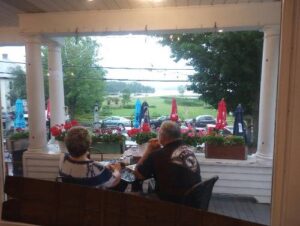
Man cannot live by golf and skiing alone, frequently there must be food and beverage, and if there is one hard and fast rule of life on the road as a writer, it’s this: when you find a good place to eat, you stick with it.
Skiers tends to fall victim to “catch as catch can” more often than they’d like to admit while playing in the mountains. Not every place is Stowe or Sugarbush when it comes to culinary options. That’s why Furbish’s in Ridgeley, Maine stays on my short list.
What a miracle! First rate wood-fired pizzas and gastropub-ish fare served up by an impressive young lion of a chef named Chip in the middle of Maine’s deepest, darkest evergreens! A sharp, attentive staff that remembers guests across winter and summers! And a delicious, clever menu that pushes boundaries while paying homage to classics. I get refurbished every time I’m within an hour or two of the place; it’s that good.
We found the restaurant by dumb luck. My accident-prone aide de camp, known to the world in my stories as “Clang,” picked it out of a hat last winter, and – lo and behold! – the food and service weren’t just a home run, but a tape measure blast into the upper deck.
The service gets a special nod as my klutz-tastic “buddy” knocked our entire pizza over in the middle of the dining room, and they didn’t even chase us out when we returned the next day.
Today’s special was a pancetta and salami with ricotta and mozzarella. Multo bene! Can anything beat a savory, wood-fired meat-lovers and a table with a view of the lake? Yes! Getting seated next to readers of your column.
“We read your stuff!” beamed a young couple enjoying draft beers and some killer BBQ. My heart warmed so fast you’d have thought my girlfriend walked in with her snowboard and said, “Let’s shred.” They were even kind enough to send me some Saddleback stickers for my car and my laptop. Thank you, guys. And thank you, Maine. I love you Maine! Heck, Maine is so cool, I’ll even settle for friends with benefits status!
As for poor Clang, he wrote himself out of the story. While several of us were flying west to ski at Mammoth Mountain in California, Clang – trying to go to the lavatory – opened up the fuselage door by mistake and was sucked into outer space 33,000 feet above a shark-infested Kentucky lake.
What? You didn’t know there were sharks in Kentucky? There are. There are volcanos too. Jack Nicklaus used one to guard a green at Valhalla. You may see it next year at the PGA Championship, unless they bulldoze it into a moat or something.
Anyway, Clang is listed as “Missing, presumed fed.” Or who knows. Maybe he faked his own death and is lying on a beach in Southeast Asia somewhere.
TO BE CONTINUED…



